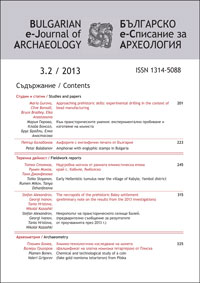Химико-технологично изследване на монета (фалшификат на златна номизма тетартерон) от Плиска
Chemical and technological study of a coin (fake gold nomisma tetarteron) from Pliska
Author(s): Plamen Bonev, Valeri GrigorovSubject(s): Archaeology
Published by: Асоциация на българските археолози
Keywords: Pliska; fake coin; EDXRF-analyses; amalgam (‘mercury’) gilding
Summary/Abstract: A fake coin found during excavations in Pliska was analyzed in the Laboratory for analyses, conservation and restoration in NIAM-BAS, Sofia in order to establish its chemical content. The coin was discovered within the levelling stratum that overlays a building burnt in the 30s – 40s of XI century. The coin is a fake of a nomisma tetarteron of Basil II (976-1025) – Constantinople, type F (1005-1025). Chemical technological analysis shows that the coin has a copper-tin core, an intermediate silver-lead layer and a gold-plated upper layer. The core alloy consists of at least two major components – copper (Cu) – around or above 75% and tin (Sn) – not more than 12%, as well as eventually silver (Ag) – up to 15%. The silver-lead layer has several percents of lead. The gold in the upper layer is at least 60% on the obverse and at least 78% on reverse. The amount of mercury is 4% on the obverse and 8% on the reverse and it is a clear indication for ‘mercury gilding’. The difference in the quantity of gold and the accompanying elements in the two sides of the foil suggests that the gilding took place in stages and at separate episodes for the two sides, resulting in different thickness of the upper layer.
Journal: Българско е-Списание за Археология
- Issue Year: 3/2013
- Issue No: 2
- Page Range: 325-338
- Page Count: 13
- Language: Bulgarian

